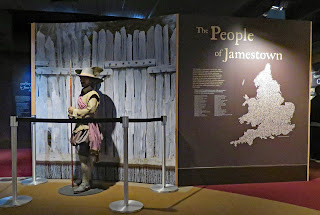Jamestown, established in 1907, is considered the first permanent English settlement in North America even though it lasted for less than 100 years. The settlement was sponsored by the Virginia Company of London as a money making venture in the belief that North America would as rich in gold as South America. The first settlers were gentlemen soldiers and their manservants. They spent valuable time searching for gold rather than digging wells, constructing shelters, and storing up food supplies. All of that combined with hostile Native Americans, a continuing drought, disease-bearing mosquitoes, and the late arrival of supply ships resulted in illness and starvation. The winter of 1609–10 brought death to over 400 settlers.

Even with all of the problems the excellent deep-water port at Jamestown which allowed ships to sail close to the river banks for loading and unloading cargo meant that the location would not be easily abandoned. As more settlers and supplies arrived it became a thriving town of several thousand people and the location of the capital of the Virginia Colony. In 1699 the capital was moved to the more suitable location of Williamsburg, Virginia and by the 1750s the Jamestown peninsula was farmland owned primarily by the Travis and Ambler families.
The town site was largely forgotten and had reverted back to forest in 1893 when 22 1/2 acres were donated to the Association for the Preservation of Virginia Antiquities. Archaeological investigations turned up foundations of the first churches. A memorial church was built on top of the foundations in 1907. In 1934 the National Park Service purchased the remaining 1500 acres. Since the island is owned by both organizations the fee schedule is confusing. It’s not free with a National Park pass but it is discounted. It is free with an Access Pass for both the pass holder and an assistant.
The visitor center is accessible. The museum and theater were closed due to coronavirus. We joined a walking tour of the fort area which was very informative. We also rolled/walked on all of the trails in both the Jamestown Fort and New Towne sections of the island. The trails are surfaced with gravel and wheelchair users may need assistance. The Archaearium Archaeology Museum is accessible. The reconstructed 1608 Glasshouse is located off site and has an accessible trail from the parking lot.
The parking lot for Historic Jamestown has RV/bus sites. It’s a bit of a trek to visitor center so visitors with small RVs may be able to park in the car lot. The Glasshouse lot is large enough for RVs. RVs are not permitted on the Island Drive loop road. They’re paved and open to cars, bikes, and pedestrians. Jamestowne 37.21042, -76.77529












This takes me back to middle school field trips.
ReplyDeleteAsk most Americans who the first European settlers were and they'll say, "The Pilgrims." But Jamestown was earlier, and Spanish were even earlier, and Vikings before that. And if you ask why settlers came, most will reply, "For religious freedom." Nah, most came for economic reasons. But the Pilgrim story rose to the top for a couple of reasons. First was that seeking God was a more wholesome story to teach the kids than the one about seeking gold. The second reason was after the Civil War the history of most things Southern was suppressed. History is written by the winners, Right?
DeleteYes, it sure is. I'm glad that the association saved the site. They're funding archeological digs and discovering that a lot of their earlier assumptions were wrong.
DeleteI imagine this place would be crowded in summer!
ReplyDeleteAnd hot! We've visited Virginia many times in the fall or early winter and it's so nice without the heat and crowds even if we do have to bundle up sometimes.
Delete